Healing Heartbreak: Yoga Poses to Soothe Emotional Pain
Heartbreak is an indelible part of the human experience, bringing with it a cascade of emotional turmoil that can leave one feeling lost, vulnerable, and profoundly pained. In these moments of deep emotional distress, finding solace and a path to healing often seems like a Herculean task. However, amidst the myriad of healing modalities, yoga emerges as a beacon of hope and restoration. This ancient practice, rooted in the synchronization of body, mind, and spirit, offers more than just physical benefits—it is a journey towards emotional liberation and healing.
Yoga, with its harmonious blend of physical poses (asanas), breathing techniques (pranayama), and meditation (dhyana), provides a holistic approach to soothing the aches of a broken heart. It gently nudges us towards inner stillness, amidst the chaos of heartbreak, fostering an environment where healing can commence. By engaging in yoga, we embark on a transformative journey that not only nurtures our physical well-being but also addresses the emotional scars of heartbreak. It’s in the gentle flow of movement and the quiet moments of reflection that we find our resilience, our strength, and, ultimately, our healing.

In this guide, we delve into the therapeutic world of yoga as a means to heal emotional pain. Through a curated selection of yoga poses and routines, we aim to provide solace and a path to recovery for those wrestling with the pangs of heartbreak. Whether you are a seasoned yogi or new to the practice, the following insights will help you harness the healing power of yoga, guiding you towards emotional balance and peace.
Understanding the Connection Between Yoga and Emotional Healing
The profound grief that accompanies heartbreak often leaves us in a state of emotional disarray, where healing seems like a distant dream. Yet, in the realm of recovery, yoga stands out not just as a practice of physical discipline but as a deeply therapeutic tool for emotional healing. This segment explores the intrinsic connection between yoga and emotional well-being, offering insight into how yoga can be a potent remedy for the wounded heart.
The Science of Yoga and Emotional Well-being
At its core, yoga is more than just a series of postures; it’s a holistic system designed to harmonize the body, mind, and spirit. This harmony is crucial in the context of emotional healing. Scientific research has begun to uncover what practitioners have known for centuries: yoga has a profound impact on our mental health. Studies suggest that regular yoga practice can significantly reduce levels of cortisol, the body’s primary stress hormone, thereby alleviating stress and promoting a state of relaxation.
Moreover, yoga stimulates the parasympathetic nervous system—the part of our autonomic nervous system responsible for ‘rest and digest’ activities. Activation of this system through yoga practice encourages a state of calmness, reduces heart rate, lowers blood pressure, and enhances respiratory function—all physiological responses that are beneficial in managing emotional distress.
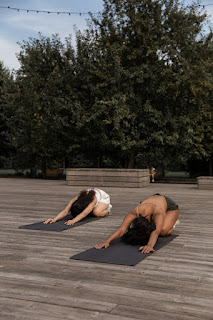
Yoga: A Path to Emotional Resilience
Yoga’s emphasis on mindfulness and present-moment awareness is another cornerstone of its healing potential. By fostering an acute awareness of the body and breath, yoga practitioners can cultivate a mindful presence, allowing them to detach from overwhelming emotions and thoughts. This detachment doesn’t mean ignoring or suppressing feelings but rather observing them without judgment. Through this process, individuals learn to recognize their emotional patterns, which is a critical step towards emotional resilience and healing.
The Role of Breathing and Meditation
Breathing techniques (pranayama) and meditation (dhyana) are integral components of yoga that further enhance its healing capabilities. Pranayama exercises, such as deep abdominal breathing, can help soothe the nervous system and reduce anxiety and depression symptoms. Meanwhile, meditation encourages a state of reflective peace, enabling individuals to confront and process their emotions in a healthy, controlled environment.
These practices teach us that healing from heartbreak is not about hastening to ‘get over’ the pain but about gently nurturing ourselves, giving ourselves the space and time to heal. Yoga offers a framework for this nurturing, guiding individuals through their emotional turmoil towards a place of strength and serenity.
Embracing Yoga for Heartbreak
Incorporating yoga into one’s routine as a means to heal from heartbreak does not require expertise or flexibility. It begins with the willingness to step onto the mat and engage with the practices, allowing the healing process to unfold naturally. The beauty of yoga lies in its accessibility and adaptability; it can be tailored to meet the needs of anyone looking to find emotional solace and recovery.
As we delve deeper into specific yoga poses designed to soothe the heart and mend the spirit in the subsequent sections, it’s essential to remember that the journey of healing is deeply personal. Yoga is not a panacea but a supportive tool that, when practiced with intention and consistency, can pave the way for emotional healing and renewal.
Yoga Poses for Heartbreak Relief
When the weight of heartbreak feels unbearable, yoga offers a sanctuary for both the body and the soul. The following yoga poses are specifically chosen for their ability to comfort, nurture, and heal a broken heart. Each pose, with its unique blend of physical alignment and emotional release, invites you to embark on a journey of healing and self-discovery.
Child’s Pose (Balasana)
- How to Enter: Start on your hands and knees in a tabletop position. Bring your big toes to touch while spreading your knees as wide as feels comfortable. Exhale as you sit your hips back onto your heels, extending your arms forward or letting them rest alongside your body. Allow your forehead to gently rest on the floor or a yoga block.
- Breathing Pattern: Take deep, slow breaths through your nose. With each exhale, imagine releasing any emotional burden, sinking deeper into comfort and peace.
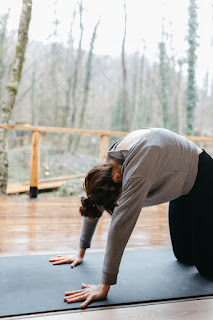
Cat-Cow Stretch (Marjaryasana-Bitilasana)
- How to Enter: Begin in a tabletop position with your wrists under your shoulders and your knees under your hips. For Cow Pose, inhale as you drop your belly towards the mat, lifting your chin and chest, and gazing up toward the ceiling. Transitioning to Cat Pose, exhale as you draw your belly to your spine and round your back toward the ceiling, releasing the crown of your head toward the floor.
- Breathing Pattern: Inhale as you move into Cow Pose, filling your lungs and heart space with air. Exhale into Cat Pose, purging your body and mind of tension and sadness.
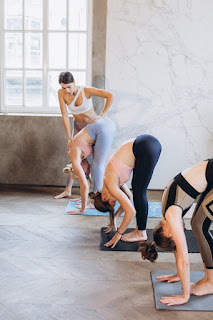
- Forward Bend (Uttanasana)
- How to Enter: Stand at the top of your mat with feet hip-width apart, and exhale as you hinge at the hips to fold forward. Bend your knees as much as needed to bring your hands to the floor. Let your head hang heavy, and hold onto each elbow with the opposite hand for a deeper release.
- Breathing Pattern: Breathe deeply in this pose, focusing on exhaling fully to encourage a deeper sense of letting go. With every inhale, find length; with every exhale, seek to fold deeper.
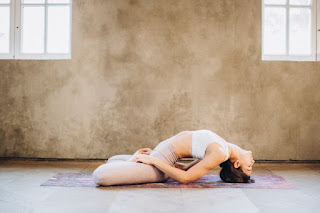
Supported Fish Pose (Matsyasana)
- How to Enter: Sit on the floor and place a yoga block or bolster horizontally behind you. Lower your back onto the block or bolster so that it supports your mid-back, and let your shoulders drape down toward the floor. Extend your legs straight out, or for more support, keep your feet flat on the ground with your knees bent. Allow your arms to rest open at your sides.
- Breathing Pattern: Focus on deep, slow breaths that expand the chest and heart area. With each inhale, visualize healing energy entering your body; with each exhale, release the heartache and sorrow.
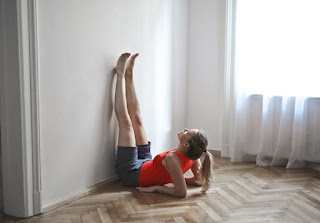
Legs-Up-the-Wall Pose (Viparita Karani)
- How to Enter: Sit next to a wall with one side of your body touching it. Gently lie back and swing your legs up onto the wall. Your back should be flat on the floor, and your sit bones as close to the wall as is comfortable for you. Let your arms rest by your sides, palms facing up.
- Breathing Pattern: Engage in gentle, rhythmic breathing. Let the inhales and exhales be of equal length, calming the mind and soothing the nervous system. Imagine stress and heartbreak flowing out of your feet and into the wall.
By incorporating these poses and their associated breathing patterns into your practice, you create a space for healing and self-reflection. This practice is not just about physical movement; it’s a pathway to inner peace and emotional recovery.
Creating a Healing Routine
Embarking on a journey of healing from heartbreak requires not just understanding and performing individual yoga poses but integrating them into a consistent, nurturing routine. This routine is designed to be both accessible and deeply healing, incorporating the poses previously discussed to soothe emotional pain and foster inner peace.
Step-by-Step Guide to Your Healing Yoga Routine
- Prepare Your Space: Choose a quiet, comfortable area where you won’t be disturbed. You may want to light a candle, play soft music, or gather any yoga props you need, such as a mat, blocks, or a bolster.
- Begin with Balasana (Child’s Pose): Start your practice in Child’s Pose, spending a few minutes here. Allow yourself to settle into the space, focusing on deep, slow breaths. With each exhale, visualize letting go of a piece of your heartache.
- Flow through Marjaryasana-Bitilasana (Cat-Cow Stretch): Transition to a tabletop position for Cat-Cow Stretch. Spend a few cycles here, letting the movement and your breath help you release tension in the spine and emotional stress. Use the inhale to open the heart in Cow Pose, and the exhale to round and release in Cat Pose.
- Move into Uttanasana (Forward Bend): Slowly rise to stand, then fold into Uttanasana. Allow your head to hang heavy, inviting a sense of surrender. Breathe deeply, with each exhale encouraging a deeper release of emotional burdens.
- Settle into Supported Matsyasana (Supported Fish Pose): Place a bolster or folded blanket under your back and lie down for a gentle heart opening in Supported Fish Pose. Let your chest rise and fall with each breath, opening yourself up to healing and acceptance.
- Conclude with Viparita Karani (Legs-Up-the-Wall Pose): Finish your routine with Legs-Up-the-Wall Pose. This restorative inversion calms the nervous system and helps to shift perspective, both physically and emotionally. Stay in this pose for 5-10 minutes, allowing your body and mind to absorb the practice’s benefits.
- Close with Meditation and Reflection: After completing the poses, sit in a comfortable position for a few minutes of meditation. Close your eyes and focus on your breath, or perhaps practice gratitude by thinking of three things you’re thankful for today. This mindfulness practice rounds off the yoga routine, centering you in the present and reinforcing your emotional resilience.
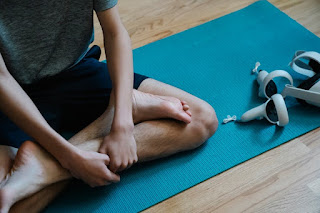
Tips for Success
- Listen to Your Body: Your yoga practice is personal, so adjust any poses as needed and take breaks whenever you feel it’s necessary.
- Consistency is Key: Try to incorporate this routine into your daily schedule, even if some days you can only manage a few minutes.
- Be Patient with Yourself: Healing from heartbreak is a process that takes time. Recognize and honor where you are in your journey without judgment.
Creating and maintaining a healing routine is a powerful step toward emotional recovery. This yoga sequence offers a structured way to begin, providing not just physical but emotional relief. As you continue to practice, you may find that yoga not only helps heal your heartbreak but also enriches your overall sense of well-being.

Integrating Mindfulness and Meditation into Your Practice
In the wake of heartbreak, it’s not uncommon to feel disconnected from the present moment, ensnared by past memories or apprehensive about the future. Integrating mindfulness and meditation into your yoga practice can be a profound way to anchor yourself in the now, facilitating deeper healing and emotional resilience. Here’s how you can enrich your yoga routine with these practices for a more holistic approach to healing heartbreak.
The Power of Mindfulness in Yoga
Mindfulness in yoga is about maintaining a moment-by-moment awareness of our thoughts, feelings, bodily sensations, and surrounding environment, all through a gentle and nurturing lens. By being fully present during each pose, you allow yourself to connect deeply with your body, acknowledging any emotional pain without judgment and embracing self-compassion.
- During Yoga Poses: Focus on your breath and the sensations in your body. If your mind wanders, gently acknowledge it and bring your attention back to your breath or the alignment of your pose.
- Transition Moments: Pay close attention to the moments between poses. These transitions are opportunities to practice mindfulness by moving slowly and with intention, fully experiencing the shift from one pose to the next.
Meditation for Emotional Healing
Meditation can be a powerful tool for healing, offering a quiet space to sit with your emotions and observe them without getting overwhelmed. It provides a way to process grief, build emotional strength, and cultivate a sense of inner peace.
- Breathing Meditation: Start or end your yoga practice with a simple breathing meditation. Sit comfortably with your eyes closed and focus on your breath. Inhale deeply through your nose, feeling your chest and belly rise, then exhale slowly through your mouth. Continue for several minutes, using your breath as an anchor whenever your mind drifts.
- Loving-Kindness Meditation: This meditation encourages a state of compassion and love towards yourself and others. Begin by silently repeating phrases of well-wishing and kindness towards yourself, such as “May I be happy, may I be healthy, may I live with ease.” Gradually, extend these wishes outwards to loved ones, acquaintances, and even those with whom you may have difficulties.

Incorporating Mindfulness and Meditation Daily
- Set Aside Dedicated Time: Try to dedicate a specific time each day for your mindfulness and meditation practice, even if it’s just for a few minutes.
- Create a Habit: Link your mindfulness or meditation practice to another daily habit, such as practicing right after your yoga routine or before bedtime, to help it become a regular part of your life.
- Be Patient and Kind to Yourself: Mindfulness and meditation are skills that develop over time. Approach your practice with patience, and don’t be hard on yourself if your mind wanders or if emotions surface. This is all part of the healing journey.
By weaving mindfulness and meditation into your yoga practice, you cultivate a deeper connection to the present moment, allowing for greater emotional clarity and peace. This integrated approach not only aids in healing the heart but also strengthens your overall well-being, guiding you towards a path of recovery and renewal after heartbreak.





